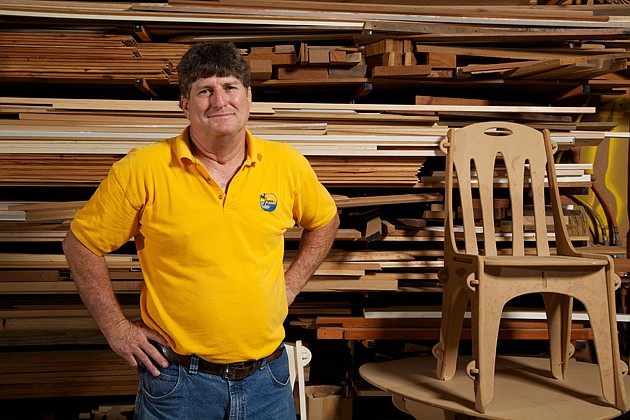When a catastrophic earthquake hit Haiti in 2010, Frank Schooley got to work.
Six months later, the longtime Lee County carpenter created a sturdy wood home that could be assembled in three hours using only a hammer and wooden pegs — no nails, screws or glue. Schooley was awarded a patent in February for his home, which he calls Shelter in a Day.
At a global conference earlier this year in Washington, D.C., the Aid and International Development Forum awarded Schooley its “most innovative product” award. A few days later, Schooley displayed the shelter at the Pentagon, where high-ranking military officers considered it as a safer alternative to tents in hostile territory. “So many guys want it for a hunting lodge,” Schooley chuckles.
The shelters, which start at $5,000 for a 12-by-12-foot home, can be easily assembled in three hours using simple drawings that require no written instructions. It ships on a pallet in pieces stacked 4 feet high. With a microfinance mortgage, Schooley estimated it might cost a family in a poor country as little as $1.50 a day.
So far, Schooley has spent a lot of money and time on the project. Filing and obtaining the patent alone cost about $20,000. “I haven't worked that hard to sell it,” says Schooley.
The technology emerged from the economic downturn. Like many contractors, Schooley's kitchen carpentry company, Tropical Kitchens, suffered when real estate crashed. He owned a $100,000 computerized machine that quickly cuts and drills holes, so he started tinkering with the cheapest material he could find, medium density fiberboard that's made from recycled wood.
Turns out, the fiberboard is so sturdy and cheap that it's perfect for building a shelter. Most carpenters shun fiberboard because you can't nail, glue or screw it. But Schooley figured out a system of holes and pegs that could hold furniture together. “Along the way I fell in love with the stuff,” Schooley says.
Schooley started making furniture such as chairs and tables from fiberboard and his peg system. He branded it Terrapeg, testing it in a restaurant near his home in Bokeelia called Little Lilly's Island Deli. “I gave her a whole suite of my furniture, and it held up,” he says.
When the Haiti earthquake hit, Schooley decided the material and his peg system were strong enough to make a house. He built a prototype nearly three years ago, which still stands at the Unitarian Universalist Church of Fort Myers he attends. “It's holding up great; it's my beta test,” Schooley says.
Schooley says he's had ongoing discussions with investors and is considering licensing the product, among other options, to grow the company. “It depends on the size of the order,” says Schooley. He's not too keen on building a manufacturing facility himself. “My role is really to come up with the next product,” he says.
Besides, Tropical Kitchens is growing again and Schooley and his wife, Doreen, are moving their company in December to a new facility on Metro Parkway in Fort Myers that's twice the size of his current one in Matlacha. “I have too much on my plate and I need to build a team,” he says.
“It's not just money,” Schooley emphasizes. He's on a mission to help the global housing problems that accompany rapid population growth in less developed countries. “It's important,” he says.






